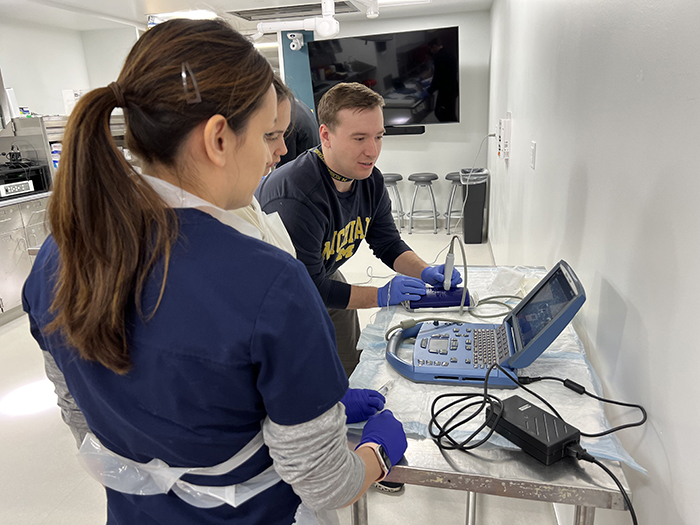
Every academic year, we proudly offer a unique opportunity to first and second year PittMed students: the Anatomy, Ultrasound, and Regional Anesthesia elective, or "Personal Enrichment Course" (PEC). Designed for those with a keen interest in anatomy, ultrasound technology, and regional anesthesia, this elective encapsulates the essence of interdisciplinary learning and early clinical exposure.
The elective’s core objective is multifaceted. It delves into a comprehensive review of musculoskeletal anatomy of the extremities, facilitates a comparative study between gross anatomical structures and their ultrasound representations, and provides hands-on experience with ultrasound scanning techniques. Moreover, it intertwines this knowledge with clinical correlations, enriching students' understanding of anatomy in a clinical context.
Conducted over three evenings, each lasting two hours, the elective accommodates between eight to 20 students per session. The format blends didactic presentations with interactive workshops, ensuring an engaging and dynamic learning environment. Small group breakouts rotate through three distinct stations: two featuring supervised live scanning sessions for upper and lower extremity blocks, and a third station focusing on needle guidance practice using gel blocks or cadaver specimens. This immersive approach garners appreciation from students for its realistic clinical simulation, fostering a deeper grasp of the subject matter.
One of the elective's notable outcomes is its role in exposing students to the captivating realm of regional anesthesia, often influencing their career trajectories. Many alumni of the elective have pursued residency training in anesthesiology, inspired by their exposure to this subspecialty.
Integral to the success of the elective are the contributions of our dedicated residents. Despite their demanding clinical schedules, residents generously volunteer their time and expertise at the end of long clinical days to mentor students, bridging the gap between theoretical learning and real-world practice. We extend our gratitude to our residents who lent their support this year: Zach Fuller, MD who served as coordinator, along with Garrett Hillsdon-Smith, MD; Mariusz Ligocki, MD; Maxine Qiu, MD; David Weidman, MD; Joe Williams, MD, all from our PGY-4 class. In addition, PGY-3 residents Song Kim, MD; Wesley Ramirez, MD; and Aaron Tarnasky, MD, MPH, served as instructors, as well as PGY-2 residents Hong Chen, MD, MPH; Henry Guo, MD; and AJ Puchany, DO. Finally, second year PittMed student Samir Yellapragada assisted with course logistics and organization and served as a liaison with the medical school. We very much appreciate the dedication of all these individuals to our medical students.
The elective has garnered consistent praise from past participants, reflecting its effectiveness in delivering valuable educational experiences. We continue to offer the course annually, usually in late January. Medical students who are interested in taking the course should visit the medical school’s PEC webpage for enrollment details.
Furthermore, we extend an open invitation to our residents, no matter their level of experience, who are passionate about education, anatomy, ultrasound imaging, and regional anesthesia to join us in teaching the course and shaping future generations of medical professionals. Those who are interested are encouraged to reach out to Steven L. Orebaugh, MD, to explore opportunities for involvement.
